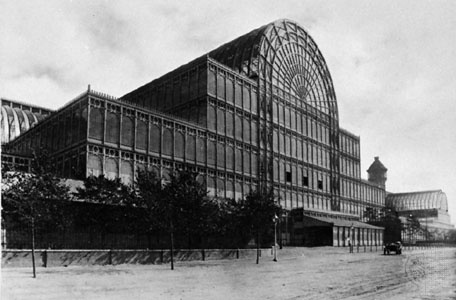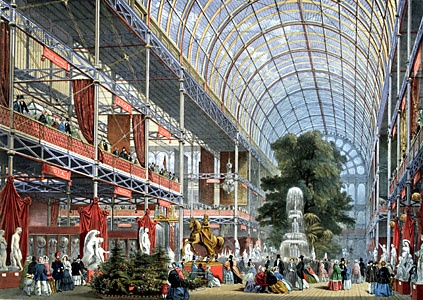Crystal Palace
building, London, United Kingdom
 giant glass-and-iron exhibition hall in Hyde Park, London, that housed the Great Exhibition of 1851. The structure was taken down and rebuilt (1852–54) at Sydenham Hill (now in the borough of Bromley), at which site it survived until 1936.
giant glass-and-iron exhibition hall in Hyde Park, London, that housed the Great Exhibition of 1851. The structure was taken down and rebuilt (1852–54) at Sydenham Hill (now in the borough of Bromley), at which site it survived until 1936.In 1849 Prince Albert, (Albert, Prince Consort of Great Britain and Ireland) husband of Queen Victoria (Victoria) and president of the Royal Society of Arts, conceived the idea of inviting international exhibitors to participate in an exposition. Plans were developed and the necessary funds speedily raised, with Victoria herself heading the list of subscribers. The exhibition opened in the Crystal Palace on May 1, 1851.
The Crystal Palace, designed by Sir Joseph Paxton (Paxton, Sir Joseph), was a remarkable construction of prefabricated parts. It consisted of an intricate network of slender iron rods sustaining walls of clear glass. The main body of the building was 1,848 feet (563 metres) long and 408 feet (124 metres) wide; the height of the central transept was 108 feet (33 metres). The construction occupied some 18 acres (7 hectares) on the ground, while its total floor area was about 990,000 square feet (92,000 square metres, or about 23 acres 【9 hectares】). On the ground floor and galleries there were more than 8 miles (13 km) of display tables.
 Some 14,000 exhibitors participated, nearly half of whom were non-British. France sent 1,760 exhibits and the United States 560. Among the American exhibits were false teeth, artificial legs, Colt's repeating pistol, Goodyear india rubber goods, chewing tobacco, and McCormick's reaper. Popular British exhibits included hydraulic presses, powerful steam engines, pumps, and automated cotton mules (spinning machines). More than six million visitors attended the exhibition, which was open to the public until October 11. The event showed a significant profit, and a closing ceremony was held on October 15. Thereafter the building was taken down, and it was rebuilt at Sydenham Hill in Upper Norwood, overlooking London from the south.
Some 14,000 exhibitors participated, nearly half of whom were non-British. France sent 1,760 exhibits and the United States 560. Among the American exhibits were false teeth, artificial legs, Colt's repeating pistol, Goodyear india rubber goods, chewing tobacco, and McCormick's reaper. Popular British exhibits included hydraulic presses, powerful steam engines, pumps, and automated cotton mules (spinning machines). More than six million visitors attended the exhibition, which was open to the public until October 11. The event showed a significant profit, and a closing ceremony was held on October 15. Thereafter the building was taken down, and it was rebuilt at Sydenham Hill in Upper Norwood, overlooking London from the south.The Crystal Palace established an architectural standard for later international fairs and exhibitions that likewise were housed in glass conservatories, the immediate successors being the Cork Exhibition of 1852, the Dublin and New York City expositions of 1853, the Munich Exhibition of 1854, and the Paris Exposition of 1855.
For a number of years the Crystal Palace was the site of shows, exhibitions, concerts, football (soccer) matches, and other entertainments. On the night of Nov. 30–Dec. 1, 1936, it was virtually destroyed by fire; the towers that survived were finally demolished in 1941 because they were deemed a conspicuous landmark for incoming German bombers.
See also from Britannica's 8th edition (1852–60), which details the 1851 exhibition as well as the rebuilt structure at Sydenham.
- Publius Sulpicius Rufus
- Publius Valerius Cato
- Publius Ventidius
- pub rock
- Pucallpa
- Pucará
- Pucci, Emilio, Marchese Di Barsento
- Puccini, Giacomo
- puccoon
- Pucelle, Jean
- Puchta, Georg Friedrich
- Puch'ŏn
- puck
- pudding
- Pudge Heffelfinger
- Pudovkin, Vsevolod Illarionovich
- Puducherry
- Pudukkottai
- Puebla
- Puebla, Battle of
- Pueblo
- pueblo architecture
- Pueblo Incident
- Pueblo Indians
- Pueblo Libre